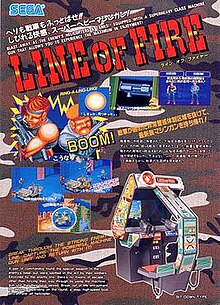| Line of Fire | |
|---|---|
 Arcade flyer | |
| Developer(s) | Sega Sanritsu Denki (Master System) |
| Publisher(s) | Sega |
| Composer(s) | M.A |
| Platform(s) | Arcade, Amiga, Amstrad CPC, Atari ST, Commodore 64, ZX Spectrum, Master System |
| Release | October 4, 1989: Arcade[1] 1990: Amiga, Amstrad, Atari ST, C64, Spectrum[2] 1991: Master System[3] |
| Genre(s) | Light gun shooter |
| Mode(s) | Single-player, multiplayer |
| Arcade system | Sega X Board |
Line of Fire is a first-person light gun shooter game developed by Sega and released for arcades in 1989. It was released with two arcade cabinet versions, a standard upright and a sit-down cockpit, both featuring two positional guns. The cockpit design allows the player(s) to sit down while playing the game, while having two-handed machine guns,[4] controlled by a potentiometer-controlled gun alignment software system.[5] The game follows a two-man commando unit as they try to escape from a terrorist facility after seizing a prototype weapon.
The arcade game was praised by critics for its pseudo-3D graphics and cockpit cabinet, but with the gameplay criticized for being derivative of Operation Wolf (1987) and Operation Thunderbolt (1988). It was converted for home computers and published by U.S. Gold in 1990, and then released for the Master System in 1991; however, the style of the latter was changed to that of an overhead run and gun video game. The home computer versions were criticized for "blocky" visuals, though reviewers found that there were some nice touches, while the Master System version also received mixed reviews.
- ^ "Line of Fire (Registration Number PA0000606082)". United States Copyright Office. Retrieved 7 June 2021.
- ^ Cite error: The named reference
release1was invoked but never defined (see the help page). - ^ "Line of Fire release information". GameFAQs. Archived from the original on 2006-06-29. Retrieved 2009-12-14.
- ^ Cite error: The named reference
Zerowas invoked but never defined (see the help page). - ^ "New Products: Sega's Line of Fire". RePlay. Vol. 15, no. 4. January 1990. p. 127.